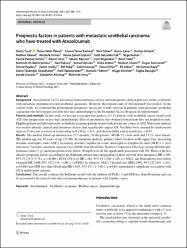Prognostic factors in patients with metastatic urothelial carcinoma who have treated with atezolizumab

Göster/
Erişim
info:eu-repo/semantics/embargoedAccessTarih
2021Yazar
Tural, DenizÖlmez, Ömer Fatih
Sümbül, Ahmet Taner
Özhan, Nail
Çakar, Burcu
Köstek, Osman
Ekenel, Meltem
Erman, Mustafa
Coşkun, Hasan Şenol
Selçukbiricik, Fatih
Keskin, Özge
Paksoy Türköz, Fatma
Oruç, Kerem
Bayram, Selami
Bilgetekin, İrem
Yıldız, Birol
Şendur, Mehmet Ali Nahit
Paksoy, Nail
Dirican, Ahmet
Erdem, Dilek
Selam, Meltem
Tanrıverdi, Özgür
Paydaş, Semra
Urakçı, Zuhat
Atağ, Elif
Güncan, Sabri
Ürün, Yüksel
Alkan, Ali
Kaya, Ali Osman
Tataroğlu Özyükseler, Deniz
Taşkaynatan, Halil
Yıldırım, Mustafa
Sönmez, Müge
Başoğlu, Tuğba
Gündüz, Şeyda
Kılıçkap, Saadettin
Artaç, Mehmet
Üst veri
Tüm öğe kaydını gösterKünye
Tural, D., Ölmez, Ö. F., Sümbül, A. T., Özhan, N., Çakar, B., Köstek, O. ... Artaç, M. (2021). Prognostic factors in patients with metastatic urothelial carcinoma who have treated with atezolizumab. International Journal of Clinical Oncology, 26(8), 1506-1513. https://dx.doi.org/10.1007/s10147-021-01936-6Özet
Background Atezolizumab (ATZ) has demonstrated antitumor activity and manageable safety in previous studies of patients with metastatic platinum-resistant urothelial carcinoma. However, the response rate of Atezolizumab was modest. In the current study, we evaluated the pretreatment prognostic factors for overall survival in patients with metastatic urothelial carcinoma who have progressed after first-line chemotherapy in the Expanded-Access Program of Atezolizumab. Patients and methods In this study, we present a retrospective analysis of 113 patients with urothelial cancer treated with ATZ after progression on first-line chemotherapy. Data of the patients was obtained from patient files and hospital records. Eligible patients included metastatic urothelial carcinoma patients treated with at least one course of ATZ. Univariate analysis was used to identify clinical and laboratory factors that significantly impact OS. Variables were retained for multivariate analysis if they had a statistical relationship with OS (p < 0.1), and then included a final model of p < 0.05. Results The median follow-up duration was 23.5 months. Of the patients, 98 (86.7%) were male and 13.3% were female. The median age was 65 years of age (37-86). In univariate analysis, primary tumor location in the upper tract, increasing absolute neutrophil count (ANC), increasing absolute lymphocyte count, neutrophil-to-lymphocyte ratio (NLR) > 3, liver metastases, baseline creatinine clearance less (GFR) than 60 ml/min, Eastern Cooperative Oncology Group (ECOG) performance status (1 >=), and hemoglobin levels below 10 mg/dl were all the significantly associated with OS. Three of the five adverse prognostic factors according to the Bellmunt criteria were independent of short survival: liver metastases HR 3.105; 95% CI 1.673-5.761; p < (0.001), ECOG PS (1 >=) HR 2.184; 95% CI 1.120-4.256; p = 0.022, and Hemoglobin level below 10 mg/dl HR 2.680; 95% CI 1.558-4.608; p < (0.001). In addition, NLR > 3 hazard ratio [HR] 2.092; 95% CI 1.031-4.243; p = 0.041 and GFR less than 60 ml/min HR 1.829; 95% CI 1.1-3.041; p = 0.02, maintained a significant association with OS in multivariate analysis. Conclusions This model confirms the Bellmunt model with the addition of NLR > 3 and GFR less than 60 ml/min and can be associated with clinical trials that use immunotherapy in patients with bladder cancer.
WoS Q Kategorisi
Q3Scopus Q Kategorisi
Q1Kaynak
International Journal of Clinical OncologyCilt
26Sayı
8Koleksiyonlar
- Makale Koleksiyonu [3770]
- PubMed İndeksli Yayınlar Koleksiyonu [4223]
- Scopus İndeksli Yayınlar Koleksiyonu [6561]
- WoS İndeksli Yayınlar Koleksiyonu [6621]

















